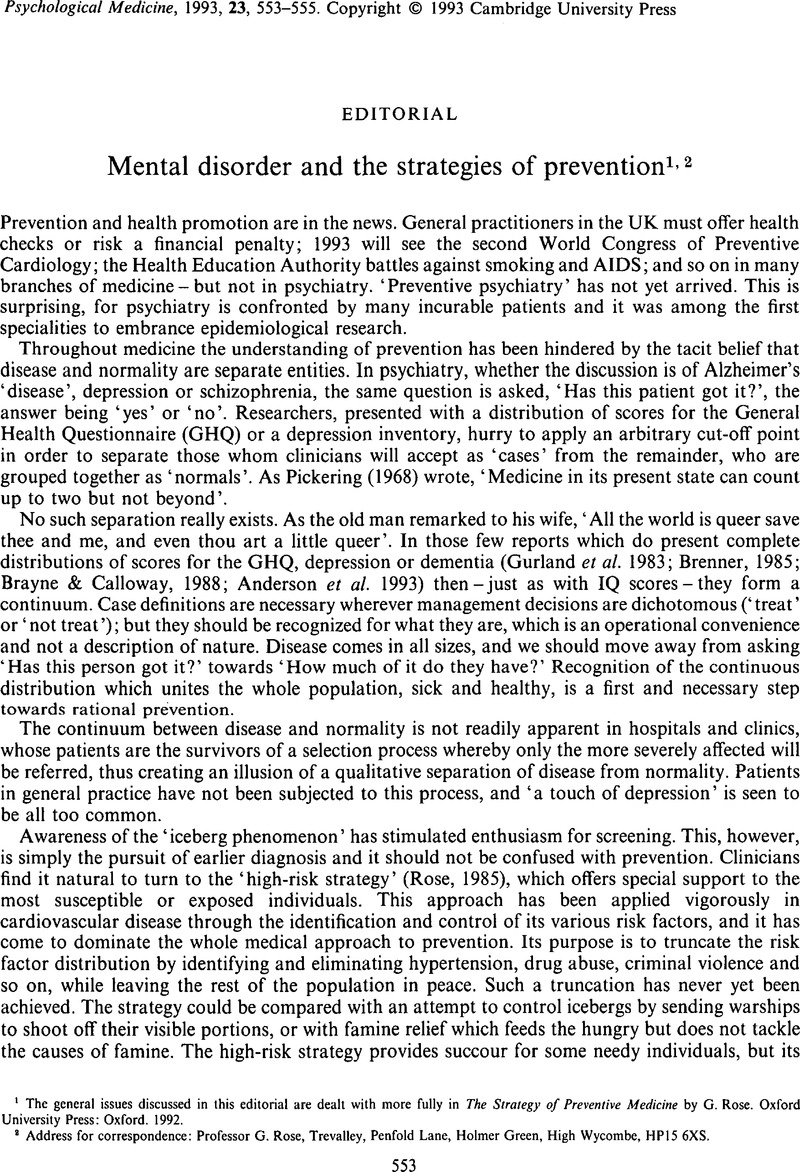Crossref Citations
This article has been cited by the following publications. This list is generated based on data provided by Crossref.
Henderson, A. S.
1995.
The Mental Health of Australians: Can Informative Data be Found?.
Australian & New Zealand Journal of Psychiatry,
Vol. 29,
Issue. 1,
p.
6.
Jorm, A. F.
1995.
The epidemiology of depressive states in the elderly: implications for recognition, intervention and prevention.
Social Psychiatry and Psychiatric Epidemiology,
Vol. 30,
Issue. 2,
p.
53.
Eaton, William W.
and
Harrison, Glynn
1996.
Prevention priorities.
Current Opinion in Psychiatry,
Vol. 9,
Issue. 2,
p.
141.
Lobo, Antonio
1996.
Elucidating mental disorder in liaison psychiatry: The Johns Hopkins “perspectives”.
Journal of Psychosomatic Research,
Vol. 41,
Issue. 1,
p.
7.
Henderson, A. S.
1996.
The Present State of Psychiatric Epidemiology.
Australian & New Zealand Journal of Psychiatry,
Vol. 30,
Issue. 1,
p.
9.
Weich, S
Lewis, G
Churchill, R
and
Mann, A
1997.
Strategies for the prevention of psychiatric disorder in primary care in south London..
Journal of Epidemiology & Community Health,
Vol. 51,
Issue. 3,
p.
304.
Henderson, A. S.
and
Kay, D. W. K.
1997.
The epidemiology of functional psychoses of late onset.
European Archives of Psychiatry and Clinical Neuroscience,
Vol. 247,
Issue. 4,
p.
176.
Tansella, Michele
1997.
Epidemiologia e Psichiatria Sociale (EPS) five years later.
Epidemiologia e Psichiatria Sociale,
Vol. 6,
Issue. 1,
p.
1.
Rosenman, Stephen J
1998.
Preventing suicide: what will work and what will not.
Medical Journal of Australia,
Vol. 169,
Issue. 2,
p.
100.
HENDERSON, A.S.
1998.
New methods in psychiatric epidemiology.
Psychiatry and Clinical Neurosciences,
Vol. 52,
Issue. S6,
Henderson, A. S.
1999.
Psychiatrie der Gegenwart 1.
p.
45.
Kelly, Christopher B.
and
Rafferty, Thérèse
1999.
Effect of increased antidepressant prescribing on suicide rate in Northern Ireland.
Psychiatric Bulletin,
Vol. 23,
Issue. 8,
p.
484.
Rosenvinge, Jan H.
and
Børresen, Runi
1999.
Preventing eating disorders—time to change programmes or paradigms? Current update and further recommendations.
European Eating Disorders Review,
Vol. 7,
Issue. 1,
p.
5.
Hart, Bret
1999.
What Public Health Could (Belatedly) Contribute to Mental Health Promotion.
Journal of Public Mental Health,
Vol. 1,
Issue. 2,
p.
22.
Rosenman, Stephen
2000.
Comment: The Prevalence and Incidence of Schizophrenia Spectrum Disorders.
Australian & New Zealand Journal of Psychiatry,
Vol. 34,
Issue. 2_suppl,
p.
S35.
Graham, Anne
Reser, Joseph
Scuderi, Carl
Zubrick, Stephen
Smith, Meg
and
Turley, Bruce
2000.
Suicide: An Australian psychological society discussion paper.
Australian Psychologist,
Vol. 35,
Issue. 1,
p.
1.
Rosenman, Stephen
2000.
Comment: the prevalence and incidence of schizophrenia spectrum disorders.
Australian and New Zealand Journal of Psychiatry,
Vol. 34,
Issue. (Suppl.),
p.
S35.
D. Goldney, Robert
2000.
The International Handbook of Suicide and Attempted Suicide.
p.
585.
Rosenman, Stephen
2000.
Comment: The Prevalence and Incidence of Schizophrenia Spectrum Disorders.
Australian & New Zealand Journal of Psychiatry,
Vol. 34,
Issue. 1_suppl,
p.
A35.
Korten, Ailsa
and
Henderson, Scott
2000.
The Australian National Survey of Mental Health and Well-Being.
British Journal of Psychiatry,
Vol. 177,
Issue. 4,
p.
325.



